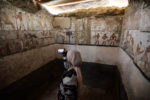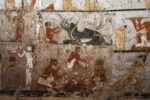 Archaeologists have discovered the beautifully painted tomb of a high-ranking priestess of the 5th Dynasty (2465-2323 B.C.) in the shadow of the Great Pyramid in Giza. An inscription on the purification basin identifies her as Hetpet and lists her many titles, among them Priestess of Hathor.
Archaeologists have discovered the beautifully painted tomb of a high-ranking priestess of the 5th Dynasty (2465-2323 B.C.) in the shadow of the Great Pyramid in Giza. An inscription on the purification basin identifies her as Hetpet and lists her many titles, among them Priestess of Hathor.
 The tomb was found in the Western Cemetery (so named because it is west of the Great Pyramid of Khufu), highly desirable eternal real estate reserved for high officials of the Old Kingdom. No funerary artifacts remain in situ, but the dry dessert climate has preserved the wall paintings in excellent condition and they provide a rare and important view of ritual, activities (hunting), work (blacksmithing) and social interaction in 5th Dynasty Egypt.
The tomb was found in the Western Cemetery (so named because it is west of the Great Pyramid of Khufu), highly desirable eternal real estate reserved for high officials of the Old Kingdom. No funerary artifacts remain in situ, but the dry dessert climate has preserved the wall paintings in excellent condition and they provide a rare and important view of ritual, activities (hunting), work (blacksmithing) and social interaction in 5th Dynasty Egypt.
The newly discovered tomb of “Hetpet” has the architectural style and the decorative elements of the fifth Dynasty with an entrance leading to an L-shape shrine with a purification basin.
On its western rare end there is a rectangular arcade lined with incense and offering holders. There is also a naos with a yet missing statue of the tomb’s owner.The tomb has very distinguished wall paintings in a very good conservation condition depicting Hetpet standing in different hunting and fishing scenes or sitting before a large offering table receiving offerings from her children.
Scenes of reaping fruits, melting metals and the fabrication of leather and papyri boats as well as musical and dancing performances are also shown on walls.
Among the most distinguished paintings in the tomb are those depicting two monkeys in two different positions. Monkeys were domestic animals at the time. The first scene shows a monkey reaping fruits while the second displays a monkey dancing in front of an orchestra.
This is not the first time Hetpet’s name has come up. A collection of 5th Dynasty objects bearing the name “Hetpet” was found by a German expedition in 1909 and shipped to Berlin. This could potentially be the contents of her tomb.
Egyptian archaeologists unveil the tomb of an Old Kingdom priestess adorned with well-preserved and rare wall paintings. pic.twitter.com/0x1LTgQg3e
— AFP news agency (@AFP) February 4, 2018
(i) Do other archaeologists tend to be jealous of the wealth of evidence that keeps turning up in Egypt?
(ii) But how much of it is evidence in any useful sense? I mean: when were the last few discoveries that wrought substantial changes in the current view of the history of Egypt and its neighbours?
In the second image, it looks like a few guys are stoking a furnace of some kind and to the right of that is a guy working with a long device of some kind. I wonder if it is a musical instrument? Or is it some sort of a bellows for the furnace?
To follow up on Nick’s comment: The 2 male figures appear to be providing air blast to a furnace with blow pipes. It is interesting that they are using lung power, not some sort mechanical bellows.
This is well before the Egyptian iron age. So if they are working metal it will probably be copper or bronze which has a lower melting point than iron. Therefore the furnace heat does not need to be as high and not as much air blast is needed.
I can’t really tell what the third figure, above the first two, is doing. It does not appear that he is hammering anything or pouring molten metal into a mold. However, metal work in antiquity was often done at floor level. So, what he is working on could be some sort of anvil.
Finally, the furnace may be used for things other than metal working such as melting sand for glass or some sort of ceramic work.
I believe the figure on the right of the photo is playing a harp. It appears that a figure above is playing a flute of some sort. I’m not sure what the yellow and red object to the left of the flute player is, it looks lie a towel dispenser to my 21st century eyes.
Maybe the flutist is doing some hot licks and needs a towel available to wipe off the sweat like jazz musicians.
Instead of blowing air to a furnace could it be glass blowing? They normally use long pipes for that too, though admittedly they usually don’t have the pipe IN the heat while blowing glass but who knows how well the artist is versed in these things…